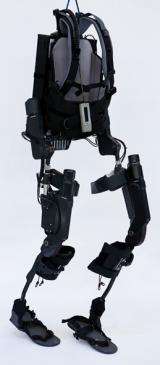October 14, 2010 weblog
Paraplegics have been given new hope for walking (w/ Video)

(PhysOrg.com) -- Berkeley Bionics unveiled eLEGS exoskeleton at a press conference on October 7 in San Francisco. Berkeley Bionics' CEO, Eythor Bender stated that their mission is to provide people with unprecedented mobility options.
The eLEGS exoskeleton is a bionic device engineered to help paraplegics stand up and walk on their own. At first the device will be offered to rehabilitation centers for use under medical supervision, and can be adjusted to fit most people between 5'2" and 6'4" and weighing 220 pounds or less.
eLEGS is battery-powered and employs a gesture-based human-machine interface that incorporates sensors and monitors the gestures the user makes to determine their intentions and then acts accordingly. A real-time computer collects data from sensors and input devices to coordinate every aspect of a single step.
The technology may prove to be extremely helpful to those who are newly injured and may still have retained muscle memory without their muscles significantly weakened. This early assistance can help patients get back on their feet and help prevent a host of minor health concerns associated with being in a wheelchair. This can range from digestive issues to poor circulation.
According to Berkeley Bionics, there are approximately 6 million people with some form of paralysis in the U.S. who are bound to wheelchairs; many of whom may have been active and athletic before an injury damaged their spinal cord. This new technology will give some of them the mobility to move their bodies and free them from their wheelchair.
In the above video Amanda Boxtel was injured in a skiing accident in 1993 and left paralyzed from the waist down. eLEGS has given Amanda her mobility back and now works as a motivational speaker.
In an Engadget interview with Berkeley Bionics CEO Eythor Bender, the system is presently made of steel and carbon fiber with lithium-ion battery packs, weighs 45 pounds, and has enough power to run for six hours of continuous walking. While an exact price was not given, Bender said that they were shooting for $100,000 and that it would be very competitive.
Clinical trials are about to begin shortly; thereafter the exoskeleton will be available to selected medical centers in July or August of 2011. Bender commented that the company is also working on a streamlined commercial version for all-day use, tentatively slated for 2013.
More information: Berkeley Bionics
© 2010 PhysOrg.com



















